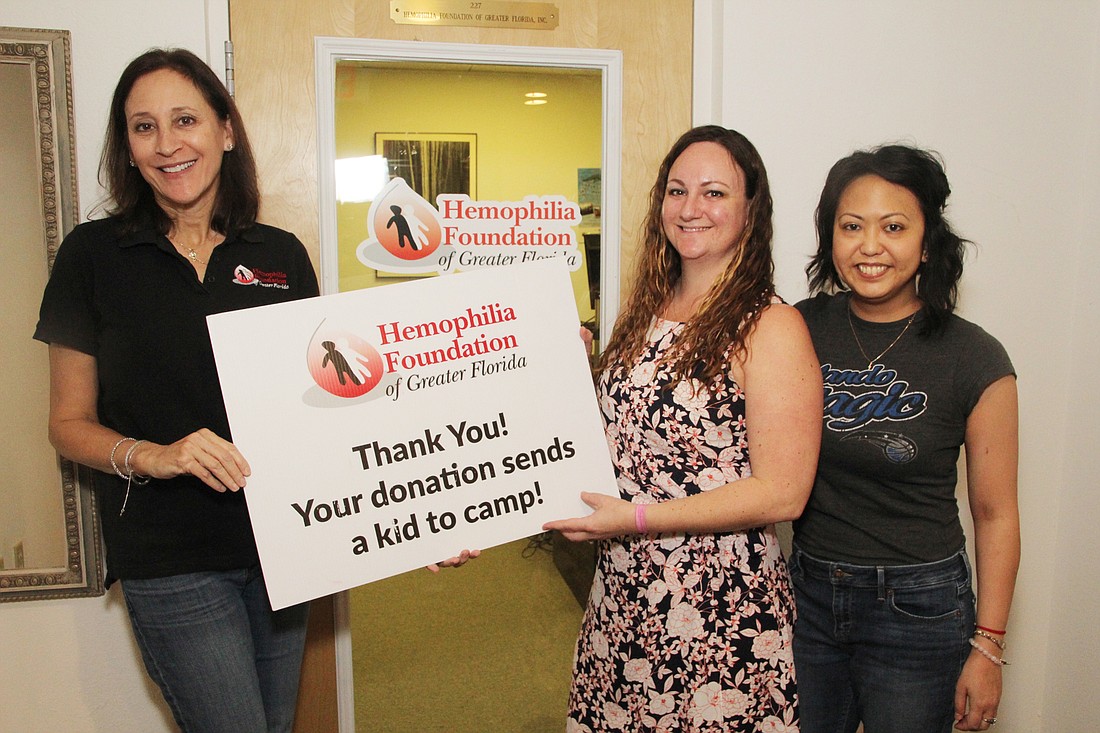- April 18, 2024
-
-
Loading

Loading

Fran Haynes knew next to nothing about hemophilia and other bleeding disorders when she considered taking a job with the Hemophilia Foundation of Greater Florida nearly 20 years ago.
These days are different. Haynes, now the Winter Park-based nonprofit’s executive director of 18 years, leads a five-person staff and oversees a wide-ranging effort to better the lives of children who suffer from bleeding disorders across all of Florida.
The Hemophilia Foundation of Greater Florida, a chapter of the National Hemophilia Foundation, has been helping families with bleeding disorders for over two decades — and it has been doing so right here in Winter Park.
Living Cautiously
Gov. Ron DeSantis recently declared the month of March to be Hemophilia Awareness Month for the state. Haynes said it’s an appreciated move and one that marks the progression in how bleeding disorders are seen and can be treated.
Hemophilia is a genetic condition in which the body’s blood has difficulty clotting properly. Cuts and other injuries can lead to significant or continuous bleeding. The condition can lead to seizures, paralysis or death if the bleeding is in a critical organ like the brain.
According to the Centers for Disease Control and Prevention, more than 3 million Americans live with hemophilia and other bleeding disorders. Men are more likely to have the condition, but women in particular are more likely to be carriers of hemophilia even if they don’t show symptoms, because the condition is carried through the X chromosome more often seen in women. The Von Willebrand bleeding disease, on the other hand, is prevalent in both men and women.
The end result for people who suffer from bleeding disorders is a more cautious lifestyle. There are so many precautions and extra steps hemophiliacs take before doing things others take for granted, Haynes said. A trip to the dentist to pull a tooth, for example, requires medication and even antibiotics to prevent bleeding.
“A child with a bleeding disorder can’t just go and get a tattoo like you or I can,” Haynes said. “They have to have their medicine, they need to talk to their doctor. (For us) it’s not extreme, it’s mainline and everywhere, but when you have a bleeding disorder you just can’t do it. You can bleed, you can get an infection — there’s so many things.”
Statewide Assistance
It’s an often-manageable condition, but constant awareness and vigilance can wear on children’s minds. Much of the foundation’s work beyond education is to provide children with recreational opportunities that other children have. Their signature summer camp, Camp Spirit, hosted 78 children, age 6 to 16 years old, with bleeding disorders last year. The camp provides medicine and medical care for the children so they can focus on having fun.
“Some of these children are isolated,” Haynes said. “They go to school, and there’s no one else with a bleeding disorder that they’re aware of. At the camp, they get to swim and do archery and fish and boat and rock climb and do things they normally can’t do. They get to be a normal kid, and it’s not about their bleeding disorder.”
It’s no small thing — each student costs $808 — and much of the funding comes from a number of pharmaceutical grants. The foundation hosts a number of fundraisers and family programs throughout the year, including four walks and 5Ks across Florida that bring in more than $150,000; family camps; golf tournaments that bring in $80,000; information classes; and more. Hemophilia foundation also has an annual Broadway gala in Orlando that brings in money.
In all, the foundation typically has an annual budget of more than $900,000, 91% of which is sent back to the bleeding-disorder community.
One of the most significant expenses is funding health care, Haynes said. Medicine used to help blood congeal has been exorbitantly expensive in the past. The executive director remembers dealing with children whose families had taken on different jobs or had divorced because of stress from paying for the medicine.
“Our (bleeding—disorder) population can rip through an insurance cap of $1 million in two years,” Haynes said. “Before the Affordable Care Act, we would tell our kids they need to go to school, get educated and make sure they get a job at a big company to get the best kind of health insurance. We don’t have to say that anymore.”
She said the insurance cap issue has been alleviated in part from the Affordable Care Act, but foundation still teaches families on how to navigate health policy. The foundation supplements its members’ trips to hemophilia treatment centers for lab work and typically spends about $60,000 to $70,000 annually for emergency medical care.
It’s a field that’s rapidly improved in the last 10 years Medical advances and health policy have made managing bleeding disorders far easier, but Haynes said there still is work to be done.
“We have longer-acting (factor medicine products), kids are now encouraged to be active at a young age so their joints aren’t debilitated,” she said. “There’s good blood supply, the products are better and made quality of life better, but there’s always room for improvement. But our goal is a cure, and that’s it. I would love for this office to be closed down because there’s no more bleeding disorders.”
INFORMATION
The Hemophilia Foundation of Greater Florida 1350 N. Orange Ave., No. 227, Winter Park
HOURS: 9 a.m. to 5 p.m. Mondays through Fridays
WEBSITE: hemophiliaflorida.org